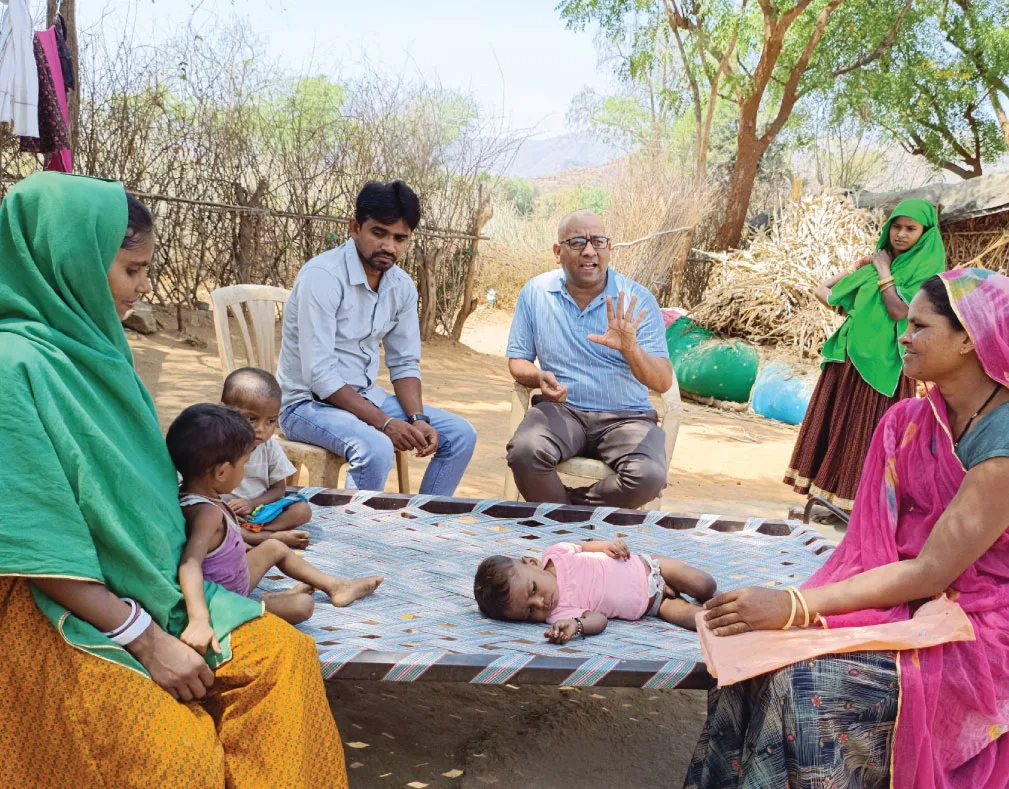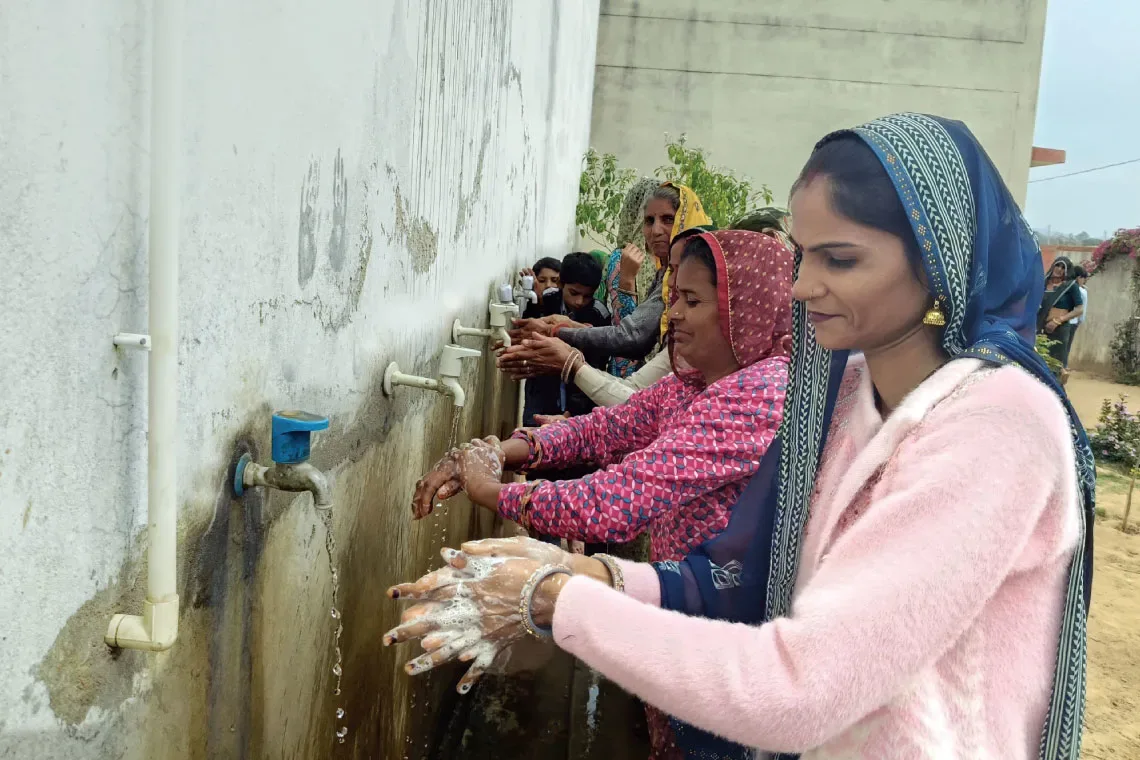Food for good
Reaching and treating 40,000-plus undernourished children in four districts of Rajasthan is the objective of a community-focused endeavor
Yuvraj Kumar does not speak as yet but he knows how to make visitors feel welcome. Almost two years of age, Yuvraj greets guests to his home in Moras village in Rajasthan’s Sirohi district with a big smile, happy to share his meagre food and rickety tricycle. There’s a cloud encircling him, though.
Bright-eyed and energetic, Yuvraj may be doomed to grow up weak and sickly if urgent attention isn’t forthcoming. He suffers from acute malnutrition, the symptoms of which are clear: weakened immune systems, delayed milestones and ailments that can impair — irreversibly even — physical and cognitive development.
Yuvraj weighed 2.5kg at birth. A year and 11 months later, he is severely underweight. His older brother, Sunil, is stunted. At five, he is only a few centimetres taller than Yuvraj. “I had no idea that the boys were suffering from malnutrition,” says their mother, 27-year-old Kamala Devi, cradling her newborn daughter. “They are skinny and small built, but we thought they would grow out of it. If I had known they were malnourished, I would have taken more care.”
This is a common refrain across districts in Rajasthan beset by severe acute malnutrition (SAM) and moderate acute malnutrition (MAM). Addressing these life-threatening conditions in a community-driven manner is the objective of a far-reaching effort supported by the Tata Trusts through their partner organisation, Centre for microFinance (CmF).
Seeded in 2023, the ‘comprehensive management of severe and moderate acute malnutrition’ programme operates in four of the state’s worst-affected districts: Sirohi, Dungarpur, Dausa and Karauli.
“These districts have large numbers of malnutrition and anaemia cases,” says Mehul Kumar Mehta, programme manager with CmF. “Data from the National Family Health Survey – 5 shows a high prevalence of underweight kids. There is so much stunting and wasting among toddlers and children that the situation demanded a more intensive engagement [than what the government can provide].”
High-low equation
In 2018, Sirohi and Karauli were designated ‘aspirational districts’ by NITI Aayog, the Indian government think tank. The two districts were identified as having low socioeconomic indicators, but with potential for improvement with appropriate social development interventions.
That’s when the state government initiated a host of initiatives to tackle malnutrition in these and other districts. But more was needed. When CmF launched its SAM-MAM campaign, the idea was to align with — and extend — the existing government programmes. “Sirohi and Karauli are already a priority with the state and central governments, but Dungarpur and Dausa also needed attention,” adds Dr Mehta.
Stunting refers to a child being short for his/her age and wasting to a child being underweight for his/her height/length. The SAM-MAM endeavour aims to promote and institutionalise the management of acute malnutrition through both community and facility-based approaches.
The intent has been to identify malnourished children in a scientific and systematic way, and then provide them with ‘energy-dense nutritional food’, which is provided in addition to regular Take Home Rations that helps to fulfil their nutritional requirement as per their age.
The process of identification is carried out by a network of village- and district-level frontline workers: anganwadi (childcare centre) staff, accredited social health activists and auxiliary nurse-midwives. These frontline workers were trained to spot, screen, diagnose, manage and treat SAM and MAM children at the community level.
The screening — typically of children up to five years of age — includes periodic measuring of weight and height, logging the data and following up to see if there are any differences from the previously recorded figures. Parents, especially mothers, are encouraged to bring their children to the nearest anganwadi centre for screening.
The frontline worker needs to be trained to take measurements accurately and then record them on a digital dashboard. Putting the statistics online means that officials across the administrative spectrum can view and review them.
The frontline worker also needs training in counselling parents like Kamala Devi about preventative and promotive care, and in improving the dietary intake of communities by focusing on the nutritional practices of mothers and their children.
The overall aim is to reach and treat 40,000-plus SAM and MAM children under the age of five across the four districts, as well as at least 70% of wasted children until recovery. This is done through national and state-specific protocols for malnutrition management.
On the menu
- Launched in 2023, the SAM-MAM programme is operational in Sirohi, Dungarpur, Dausa and Karauli districts
- The objective of the programme is to reach and treat 40,000+ children suffering from malnutrition
- More than 26,000 children have been treated thus far through food-based interventions
- 5,300 frontline workers have been trained to identify, screen and log data about undernourished children, and to provide home-based counselling for families
Fortified fix
The collateral benefits include improvement in the delivery of health and nutrition services not just to children, but also to pregnant and lactating mothers. Included are the preparation and serving of meals with fortified ingredients at anganwadi centres, and setting aside similarly fortified take-home rations for the entire family (these are currently supplied by the government).
More than 5,300 frontline workers have been trained by CmF thus far. Educating them about growth monitoring and food fortification has been a big challenge here. Manisha Devi, a cook with the senior secondary school in Dhanga village in Sirohi district, says she used to throw out the fortified rice supplied by the government thinking it had gone bad.
“When I washed the rice, kernels of it would float up to the surface,” says Ms Manisha. “At first I thought someone had mixed in bits of plastic, so we would not serve it to the children. I didn’t know then that this was rice fortified with iron, folic acid and vitamin B12.”
Dr Mehta adds: “There were gaps in information around why fortified rice is being provided to schools. The procedures for how to identify and manage the fortified rice while cooking were not there, and nor was there any understanding about the importance of fortified rice. Or how it was being provided to children and the community at large to reduce the burden of anaemia. So kids were not served this and their nutrition levels were not improving.”
There are several socioeconomic reasons why malnutrition has become so rampant in some parts of Rajasthan. Villagers here are either small-scale farmers or daily-wage labourers. Parents go off to work, leaving their infants to be managed either by older siblings or grandparents. Little attention is paid to the food intake of these children.

Climate change has forced a lot of farmers to give up agriculture and migrate from place to place looking for a living. Families on the move can’t always provide properly for their children, who then end up eating whatever they can get their hands on. Cheap and easily available processed snacks take care of the hunger pangs but don’t provide the necessary nutrition.
It has been a struggle to convince families about diet diversity and the need to include ‘tricolour’ food from different food groups — red and orange lentils; white rice or milk products; and green vegetables — so that children can get all the micronutrients they need.
“Typically, the villagers we work with are farmers with small land holdings,” says Prashanto Bagchi, district project officer with CmF. “They can manage only one or two crops a year, so we advise them to grow lucrative cash crops and vegetables, even if in limited amounts.” That brings some diversity to the table.
Anganwadi workers are now also educating parents about age-appropriate portion sizes for children. “A small bowl of food for younger children and a larger bowl for those older,” says Mr Bagchi. “This ensures that the older children don’t eat up the portion meant for the younger ones, which is another reason for undernourishment of kids under five.”
Alongside nutrition and supplementary health habits, CmF has also trained frontline workers to promote better hygiene among kids. Every anganwadi in the project area now has a handwashing corner. “We insist that the kids who come to the centre wash their hands frequently, especially before meals,” says Pushpa Choudhary, a frontline worker. “A lot of illnesses spread due to a lack of hygiene in the villages.”
Uttam Singh, the child development project officer for Sirohi district, is generous in her praise for the programme. “We have received a lot of support for our programmes from CmF,” she says. “At the government level, we train frontline workers too, but we have fewer staff and are not able to reach everybody. The outcomes [of the programme] have been beneficial.”
Ms Singh emphasises that the dashboard created by CmF to digitise the height-weight data collected from mass screenings has been helpful. “I can simply log in from my office and see the statistics for all four districts, down to the village level,” she says.
The state government has now requested CmF to help create poshan vatikas (nutrition gardens). In this, small patches of land are used to grow vegetables, fruits and even medicinal plants that can be used to improve nutrition levels. CmF has been tasked with seeing how these gardens can be designed and where they can be placed.
The idea is for the community to eventually take over the programme entirely. “The community may not be able to identify a malnourished child, but it can tell when a child is sick,” says Dr Mehta. “Building community ownership is imperative for the success of the programme.”
